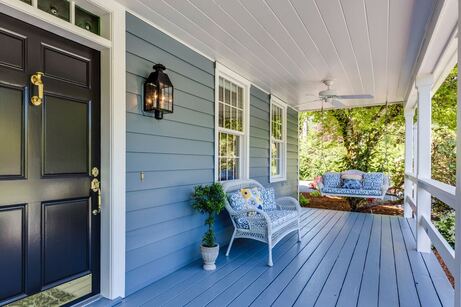"Green building encapsulates everything from design and construction to operation and maintenance." Eco-Friendly construction practices and green building are no longer mere buzzwords; they represent a critical shift in how we approach the design and construction of our living spaces. They offer a holistic approach to environmental responsibility and resource efficiency. Green building encapsulates everything from design and construction to operation and maintenance, fostering a sustainable and healthy environment. On the other hand, eco-friendly construction practices introduce innovative methods that diminish environmental impact while still creating sturdy, long-lasting structures. As more people search for a new eco-friendly home, understanding these practices becomes vital in making informed, responsible choices. Opting for a green home means investing in a sustainable lifestyle. As well as contributing to a healthier planet and paving the way for future generations to live in harmony with nature. Building choices that help the environment and your budgetEco-friendly construction practices and green building represent a significant shift in the construction industry's response to environmental concerns. The essence of eco-friendly construction practices is the principle of sustainability. It includes using resources responsibly, implementing energy-efficient technologies, reducing waste, and creating healthier living environments. These practices pave the way for constructions that harmonize with their surroundings rather than disrupting them. From a homeowner's perspective, the benefits are significant. Eco-friendly constructions conserve resources, decreasing utility bills over the long term. These homes tend to maintain their value better as the demand for green homes grows. Furthermore, non-toxic materials and better ventilation systems improve indoor air quality, promoting healthier living. "Eco-friendly constructions conserve resources, decreasing utility bills over the long term." Key Components of an Eco-Friendly Construction Eco-friendly construction involves several key components that differentiate it from conventional building practices:
"Adopt construction methods that produce less waste and promote recycling of materials." Each of these components plays a significant role in reducing the environmental footprint of a building while enhancing the quality of life for those who reside within its walls. Eco-Friendly Construction Materials Eco-friendly construction materials are the core of sustainable construction practices. These building materials are sourced and produced in a way that significantly reduces their environmental impact, often involving recycling processes or sustainable harvesting methods. These often outperform traditional materials in durability, maintenance, and overall lifecycle costs. Moreover, they contribute to healthier indoor environments by reducing the use of harmful chemicals. A wide range of eco-friendly construction materials are now available for various applications. Recycled steel, for instance, is a popular choice for structural work due to its strength and durability. Bamboo, a rapidly renewable resource, serves as a versatile material for flooring, decking, and even structural elements. Insulation materials derived from recycled paper or sheep's wool are gaining popularity for their efficiency and sustainability. We contribute to a greener and more sustainable future by choosing these materials. The Aesthetics and Comfort of Eco-Friendly Homes "Eco-friendly homes blend form and function to enhance the living experience." Eco-friendly homes are not just about sustainability. They're also about creating spaces that blend form and function to enhance the living experience. Through thoughtful design, these homes meld aesthetic appeal with environmental consciousness, often utilizing natural light, organic shapes, and sustainable materials that lend an elegant simplicity. Natural elements incorporated into the design can foster a sense of well-being and connection to the environment. Moving to an eco-friendly home is not only an environmentally responsible choice but one that prioritizes your well-being and comfort. The increased health benefits, visual appeal, and ethical alignment with sustainability add significant value to your new home. Living in an eco-friendly home becomes not just a practical decision but a fulfilling one that resonates with modern sensibilities and personal values. Making Your Move: Transitioning to a Green Building Understanding the value of green living is crucial in making an informed decision. When searching for a green home that suits your needs, you must consider various factors, such as energy efficiency, water conservation, and sustainable materials used in construction. Notice that while the initial cost of a green home might be higher, the long-term savings on utility bills often offset the difference. Finally, even moving can align with your green living goals. Create a green moving checklist and make your relocation sustainable. Choose reusable packing materials, consider carbon-neutral moving companies, and plan the move to minimize trips. Embrace these practices and make your relocation a harmonious part of your commitment to a sustainable lifestyle. Eco-Friendly Construction Practices and Green Building SolutionsThe built environment is a major contributor to global carbon emissions and climate change. Green buildings present a potent solution to this pressing issue by minimizing their carbon footprint in various ways. They utilize energy-efficient designs and technologies, significantly reducing energy consumption for heating, cooling, and everyday activities. This lower energy demand, especially when met by renewable sources, translates to fewer greenhouse gas emissions. Green buildings also contribute to climate change mitigation by promoting water conservation and reducing waste production. Choosing a green building is a decision that benefits the individual and the collective. On a personal level, residents experience lower utility bills, improved health, and the satisfaction of leading a more sustainable lifestyle. On a broader scale, each green building contributes to the global effort to mitigate climate change, making it a responsible choice for those mindful of its environmental impact. How to Identify a Truly Green Building A checklist can prove handy in your quest for a genuinely green building. Look for sustainable construction materials, energy-efficient design, water-saving features, and good indoor environmental quality. A green building should also consider site location and design to minimize environmental impact. Certifications serve as a reliable guide to assess the green credentials of a building. Certifications like LEED (Leadership in Energy and Environmental Design) are globally recognized standards that measure the building's environmental performance. They are essential in helping you make an informed choice about your green home. "A green building should also consider site location and design to minimize environmental impact." Make your Next Home a Green BuildingEmbracing eco-friendly construction practices and green building offers benefits, from reduced environmental impact to cost savings and improved health. These practices, entailing sustainable materials, energy-efficient designs, and renewable energy, set the stage for our shared sustainable future. As you consider your next move, take these benefits into account. Opting for a green home provides immediate advantages and contributes to global sustainability efforts. Your choice can inspire others, building momentum for this vital shift in construction and living practices. So, as you plan your relocation, make the decision that benefits our planet: make your next home a green building. AuthorThomas Gill is a moving professional currently working at Pro Movers Miami. He says that nowadays, more and more people are deciding to move into green buildings and create a healthier life for themselves and the environment. He states that every client that decided to start a new life in an eco-friendly building had only good reviews and experience. Want more expert advice to help you design, build and renovate your home?Paul Netscher has written 2 easy to read books 'An Introduction to Building and Renovating Houses - Volumes 1 and 2'. An Introduction to Building and Renovating Houses Volume 1 deals with Hiring Contractors, Managing Construction and Finishing Your Home. and Designing your ideal home Volume 2 deals with Finding Your Ideal Property and Designing Your Dream Home. ("Great for those that DIY. Very helpful in home renovations!" said a Reader on Amazon.com 5*****) These books are available from Amazon and other online bookstores in paper and ebook. This article is a guest post and the owners of this website take no responsibility for the content or it's originality. The website publishes this article in good faith with the undertaking from the author and supplier that the content has not been plagiarised. Please report any errors in the article to the website owners. Should you prove the content is not original the article will be immediately taken down.
0 Comments
Leave a Reply. |
AuthorI’m a construction professional, author of several successful construction management books, and a home owner. I’ve made mistakes in construction management, I’ve seen others make mistakes, but importantly I’ve had multiple successful construction projects and I’ve learned from the mistakes. I want to share these lessons and my knowledge with you. Also available from:
Amazon Au, Amazon DE, Amazon ES, Amazon CA, Amazon IT, Amazon FR, Amazon NL, Amazon India and 'An Introduction to Building Houses - Volume 2 Finding Your Ideal Property and Designing Your Dream Home'
Archives
July 2024
CategoriesWe welcome genuine comments, especially comments that add additional information to the subject matter in the article. We however reserve the right to remove inappropriate comments, which includes comments that have nothing to do with the subject, comments that include inappropriate language, and comments that are an advertisement for a product or company, or which include an advertising link. Comments must be in English. We will not enter into discussion on why a particular comment was removed.
|









 RSS Feed
RSS Feed


